Japan
Wood Products Prices
Dollar Exchange Rates of 10th
April 2017
Japan Yen 110.94
Reports From Japan
Falling unemployment and low inflation
boosts
consumer confidence
According to the Cabinet Office, consumer confidence in
Japan improved more than expected in March rising to a
three year high. All components of the consumer
confidence index trended higher with the indexes for
income growth, employment, the willingness to buy
durable goods and the measure for overall livelihood
rising surprisingly sharply.
The boost in consumer confidence stems partly from the
decline in unemployment and because inflation is minimal
which means households feel there disposable income is
stable. The main downside to an even bigger boost to
consumer confidence is the poor wage growth after the
latest round of wage negotiations with the unions.
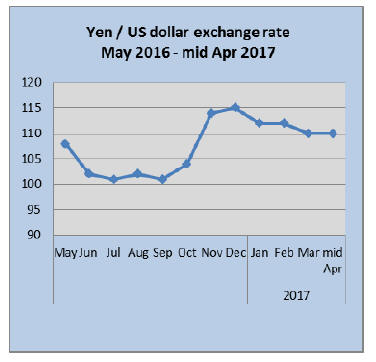
Yen swings higher again
The yen barely moved from 110 to the US dollar in the
first two weeks of April and still hovers at a four month
high against the dollar.
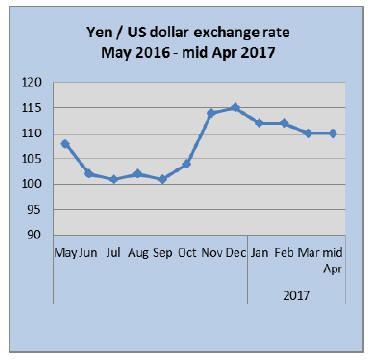
Uncertainty in the US and regional tensions have
driven
investors back to the safe haven Yen. The stronger Yen
will boost importer sentiment and will work to suppress
inflation because of its impact in lower energy costs.
Home renovation statistics would improve
understanding of housing market trends
The stock of old houses in Japan, many of which have
been left untended, is of concern to the authorities as these
houses could eventually become unsafe. The government
has brought in legislation which encourages owners of
homes no longer occupied to either sell or demolish but
selling an old home in Japan is no easy task.
In recent years the concept of house reform (renovation)
has gained ground driven partly by the interest from
middle income earners to own a home.
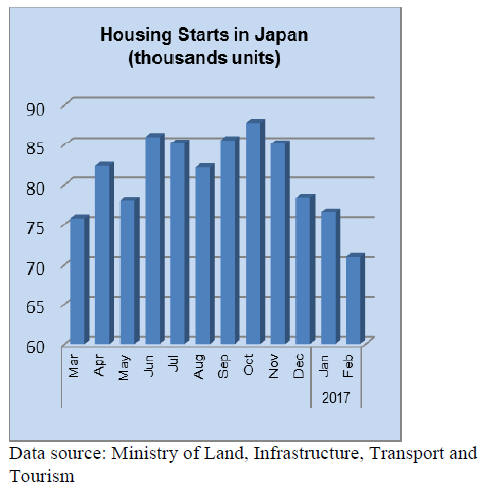
Most of the old homes on the market were built in
the
1980s but were not built to last, commonly in Japan,
homeowners assume they will have to replace their house
after 30-40 years which tends to lead to minimal
maintenance.
Against this background the new trend in ¡®reform¡¯ is
creating opportunities but has exposed some problems, the
main one being the absence of consistent regulatory
supervision.
Unlike construction companies, a ¡®reform¡¯ company can
open without registration which means anyone can start a
reform business and is under no obligation to report
customer spending on remodeling. This diminishes to
value of statistics on the housing market as only new build
data is available.
Exhibition exploring Japanese domestic architecture
The Barbican Centre, a performing arts and exhibition
centre in London, is one of the largest of its kind in Europe
and is currently exhibiting Japanese architecture.
The Barbican website has details of its exhibition ¡®the
Japanese house¡¯ which the Barbican says ¡°is the UK¡¯s first
major exhibition exploring Japanese domestic architecture
from the end of the Second World War, a period which
has consistently produced some of the most influential and
ground-breaking examples of modern and contemporary
design.
In the wake of the war, the widespread devastation of
Tokyo and other Japanese cities brought an urgent need
for new housing and the single family house became the
foremost site for architectural experimentation and debate.
Since then, Japanese architects have used their designs to
propose radical critiques of society and innovative
solutions to changing lifestyles.¡±
See:
https://www.barbican.org.uk/artgallery/eventdetail.
asp?ID=19951
Import round up
Doors
Year on year Japan¡¯s February 2017 imports of wooden
doors (HS 441820) were down once again, this time
falling 32% compared to February 2016 and from a month
earlier they were down around 19%.
The continuing downward trend in wooden door imports
marks five consecutive monthly declines since September
2016. The level of February imports is an unprecedented
low.
The top suppliers in February in order of rank were China
(46%), the Philippines (24%), Indonesia (13%) and
Malaysia (6%) accounting for 89% of Japan¡¯s wooden
door imports for the month.
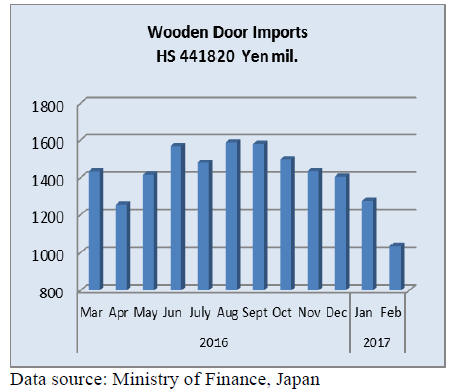
Windows
Year on year, Japan¡¯s wooden window (HS441810)
imports fell 7% but February 2017 imports rose 7%
compared to levels reported for January 2017.
Four shippers accounted for almost 80% of Japan¡¯s
February 2017 wooden window imports led by the US
(42%), China (19%) and the Philippines (18%).
The balance of February 2017 imports came from EU
member countries with Italy and Sweden together
accounting for 18% of the value of windows shipped.
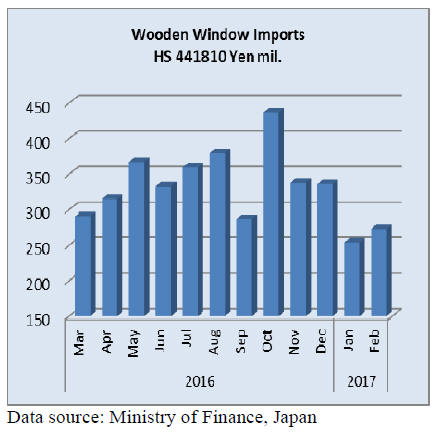
Assembled flooring
Three categories of assembled flooring are included in the
data presented below, HS 441871, 72 and 79.
There was a massive correction in Japan¡¯s imports of
assembled flooring in February 2017 with the value of
imports falling over 50%.
Assembled flooring imports had been rising since August
2016 and there was an unexpected burst in imports in
December last year followed by another surge in January
this year. Against the backdrop of a weaker yen making
imports more expensive the sudden rise is difficult to
explain.
The top assembled flooring suppliers to Japan in
February
2017 were Indonesia (37%), China (28%) and Sweden
(15%).
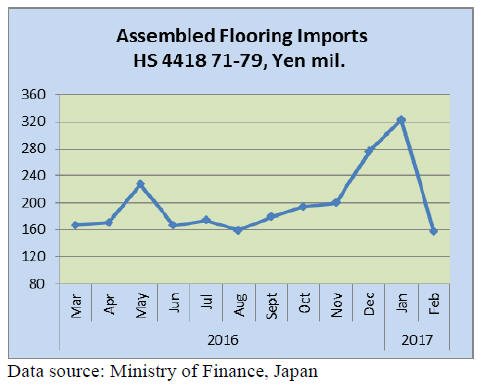
Plywood
The figure below shows the trend in imports of 4
categories of plywood, HS 441210/31/32 and 39.
Throughout 2016, as was the case in 2015, almost 90% of
Japan¡¯s plywood imports are from Malaysia, Indonesia
and China.
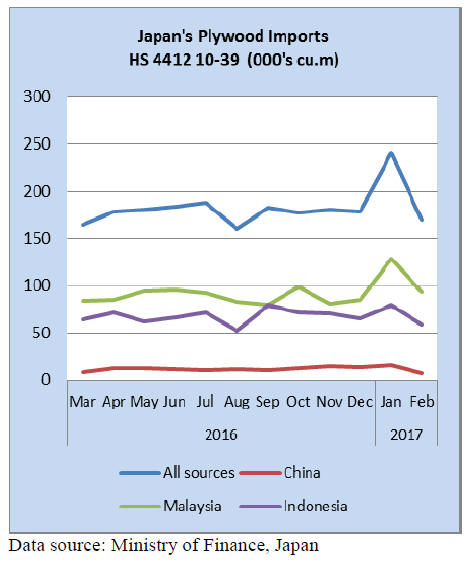
This trend continued into February this year. Most
of
Japan¡¯s plywood imports are within HS 441231 (87%).
Year on year February 2017 shipments of plywood from
China fell 25% and shipments from Indonesia also
dropped (-17%). On the other hand, February shipments
from Malaysia increased 15%.
While Malaysian shippers managed a year on year
increase imports from all three of the major suppliers
Malaysia, Indonesia and China in February 2017 were
well below levels in January.
China posted the steepest decline with February
shipments
to Japan dropping 53%. Shipments from Malaysia and
Indonesia were down 28% and 26% respectively.
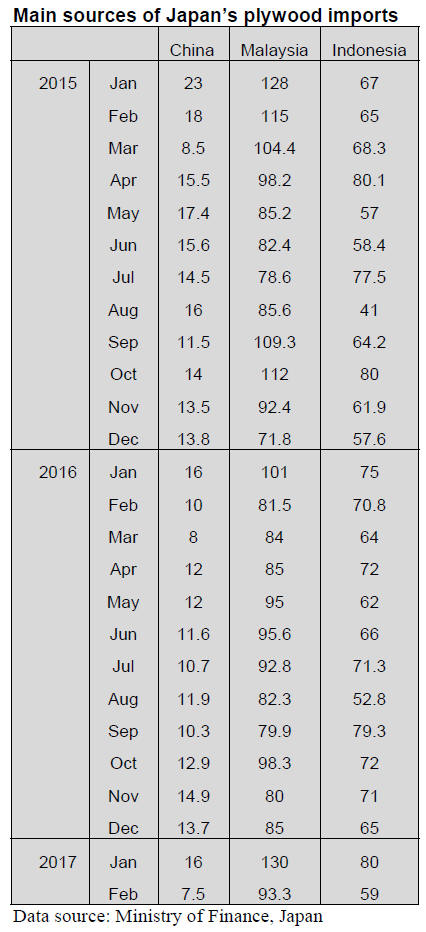
Trade news from the Japan Lumber Reports (JLR)
For the JLR report please see:
http://www.nmokuzai.
com/modules/general/index.php?id=7
Questions and answers on the Clean Wood law
The Clean Wood Act will be effective since May 20 this
year. Please refer to the article of Clean Wood Act in No.
693 dated March 10, 2017.
Registration of business will not start until this
fall so
there is ample time but it is necessary to register when
delivery of legally proven wood products is requested.
With this Act what would change and what one has to do
to deal with this Act.
Question : Is there any penalty for violation of the Act?
Since the Clean Wood Act is promotion law so there is no
legal penalty. If one handles suspicious wood products and
they are found illegally harvested wood later, there will
not be any penalty. However, if one handles the products
knowing they are illegally harvested wood, there are
possibilities of inspection, having guiding advice.
If one acts maliciously, registration will be cancelled and
the name will be publicised.
Question : What does the Act specify ¡®wood¡¯ ?
It covers wide range of products from logs, lumber,
plywood, building materials, furniture and paper.
In these, there will be a certain standard how much wood
is used for furniture. If wood use is less than the standard,
it is not subject of the law. If products are mainly made of
recycled wood like MDF, OSB and particleboard, they are
not the subject.
Products like concrete forming panel, scaffolding and
sheet pile, which are used only at construction site are not
subject but raw materials to make such products
like plywood and lumber need to be proved legality.
Question : What does ¡®confirmation of legality¡¯ mean ?
Present methods to prove legality are forest certifications
like FSC, PEFC and SGEC, group certification by
industrial group and individual certification system like
major paper manufacturing companies have then local
products certification by prefecture.
Forest certification is sufficient by itself. Items mentioned
on statement of delivery of Group certification may be
changed or harvest registration may be requested to attach.
On imported wood products, it is necessary to have
statement to verify that the product is conformed to legal
system of producing countries.
If such certification is not available, secondary
certification such as EU wood rules or Lacey Act of the
United States may be used.
Question : If legality of wood product is not proved, is
handling such product prohibited ?
Even with hard effort, if legality is not proved, such
product can be handle3d separate from legally proven
products. Purpose of the Act is to keep reducing such
products little by little.
Question : What is difference between certified enterprise
by group certification and registered enterprises by the
Clean Wood Act ?
Group certification is a mean to confirm legality and
registered enterprises are entitled to use this method.
Means of confirming legality are various like prefectural
certification.
Registered enterprises confirm legality by forest
certifications and group certification and declare to handle
such products actively.
Once one becomes registered enterprise, it does not mean
that one cancels group certification since registration does
not mean to have means of proving legality.
Question : Who are wood related enterprises ?
There are two kinds. First group is ones which receive
wood initially such as importers, which receive logs or
lumber from overseas suppliers and log auction markets,
which receive logs direct from log harvesters. Then there
is second group, which received wood from first group
such as wood processor, wood distributor and final use of
wood like house builders.
Lumber mills, plywood mills and wood chip mills, which
receive wood directly from log suppliers are classified as
the first group but if logs are supplied through auction
market, it is the second group.
Timber owners, log suppliers, overseas wood products
suppliers, DIY stores and retailers are not subject of the
Act.
Plywood production in February
New orders for softwood plywood by major precutting
plants are slowing down now but there is no cancellation
for delayed deliveries. Since total inventories are low,
users fell uneasiness of future deliveries.
Import plywood market is slightly firming on structural
and green concrete forming panels but the prices of coated
plywood are weakening and there are some spot low
prices.
Production of domestic softwood plywood in February
was 234,000 cbm, 0.8% less than February last year and
2.7% more than January. In this, structural panel
production was 224,500 cbm, 0.6% less and 3.0% more.
Meantime, shipment of softwood plywood was 231,600
cbm, 0.9% less and1.4% less.
The production exceeded the shipment for the first time in
eight months so the inventories were 78,900 cbm, 2,400
cbm increase from January. The supply had been tight
since last April then deliveries are much quicker since
March but softwood inventories are only for one week
consumption so once orders increase from precutting
plants, the supply would get tight in no time.
Plywood mills continue full production
Import plywood supply in February was 206,400 cbm,
5.7% less and 33.1% less. It was nearly 100,000 cbm less
than January.
By source, 65,600 cbm from Malaysia, 14.2% more and
27.6 % less. 65,600 cbm from Indonesia, 15.1% less and
25.9% less. 32,500 cbm from China, 22.2% less and
52.9% less.
Actually, January arrivals were high with over 300,000
cbm by orders placed in late fall, which arrived in
December, then carried over volume from December by
the customs clearance delay is registered in January.
The market of imported plywood in Japan continues weak
with sluggish demand for coated concrete forming panels.

Review of plywood and panel market of 2016
Total supply of wood panel in 2016 was 8,795,762 cbm,
3% more than 2015. Majority of about 260 M cbm
increase was plywood. Domestic plywood production
exceeded three million cbm, the highest since 2007.
Softwood plywood marked record high of 2,897,218 cbm,
11.9% more than 2015.
Housing starts in 2016 were 967,237 units, 6.4% more
than 2015. In particular, wood based units were 546,336
units, 8.3% more. This stimulated demand for plywood
and other panels. Imported plywood volume was
2,770,650 cbm, 4% or 115,000 cbm less than 2015, the
lowest since 1990. Wooden panels like particleboard,
MDF and OSB increased slightly.
Domestic plywood alone increased significantly. Domestic
plywood production in 2013 was 2,810 M cbm when
housing starts were more than 2016. Structural plywood
production in 2013 was about 2,450,000 cbm then it
increased to 2,800,000 cbm in 2016.
An average production during 2013 and 2015 was about
2,430,000 cbm so the increase in 2016 was about 400 M
cbm. Structural plywood production maintained level of
2013 even when housing starts dropped from about
980,000 units in 2013 to about 900,000 units in 2014 and
2015.
Meantime, import plywood peaked in 2013 and the
volume dropped by about 150,000 cbm in 2014 and about
600,000 cbm in 2015. To fill short supply of imported
plywood, domestic plywood production increased.
Domestic panel was 4,958,058 cbm, 7% more then
imported panel was 3,837,740 cbm, 2% less. Therefore,
share of domestic was 56.4% and import 43.6%. Domestic
panel increased by 324,665 cbm. Besides plywood, MDF
increased by 222,000 cbm and particleboard by about 20
,000 cbm.
Imported panel volume dropped by about 80,000 cbm,
three consecutive years¡¯ decline. The largest factor is
decline of imported plywood, which was down by 115,000
cbm in 2016 from 2015. Imported MDF increased by
7,500 cbm and particleboard also increased by 21,000
cbm. Majority of the increase is OSB.
Market of imported plywood mainly concrete forming
panels remained sluggish then the market turned round in
third quarter finally bu t the demand remained weak so the
import was held down all through the year. As a result,
Malaysian plywood import was the lowest at 1,075,700
cbm since the peak year of 2006.
Despite reduced import, the market prices continued
decreasing with weak demand. Irritated with prolonging
depressed market in Japan, Malaysian plywood mills
decided to reduce the supply volume for Japan uniformly
in August until Japan market recovers.
High export prices became chronic since availability
of
quality logs becomes hard and transportation cost climbs
as harvest areas are farther and farther.
The Sarawak government put tight control on illegal log
harvest and tighten log export quota.so log availability
gets less and less and the prices continue climb. There
seems to be any chance of increasing log supply in
Sarawak. Sarawak plywood suppliers proposed higher
prices and at the same time, the yen started skidding so the
import yen cost increased, which discouraged purchase by
the Japanese importers.
Indonesian import was 903,300 cbm, 44,300 cbm more
than 2015. Indonesian plywood mainly used for floor base
as compared to Malaysian¡¯s concrete forming panel. The
prices of Indonesian plywood dropped some in Japan
market but not as much as Malaysian plywood.
Japanese softwood plywood mills are now trying to take
over floor base market so the mills are manufacturing new
product apart from traditional structural panel. Some mills
are now manufacturing softwood plywood for concrete
forming to compete with Malaysian plywood.
|